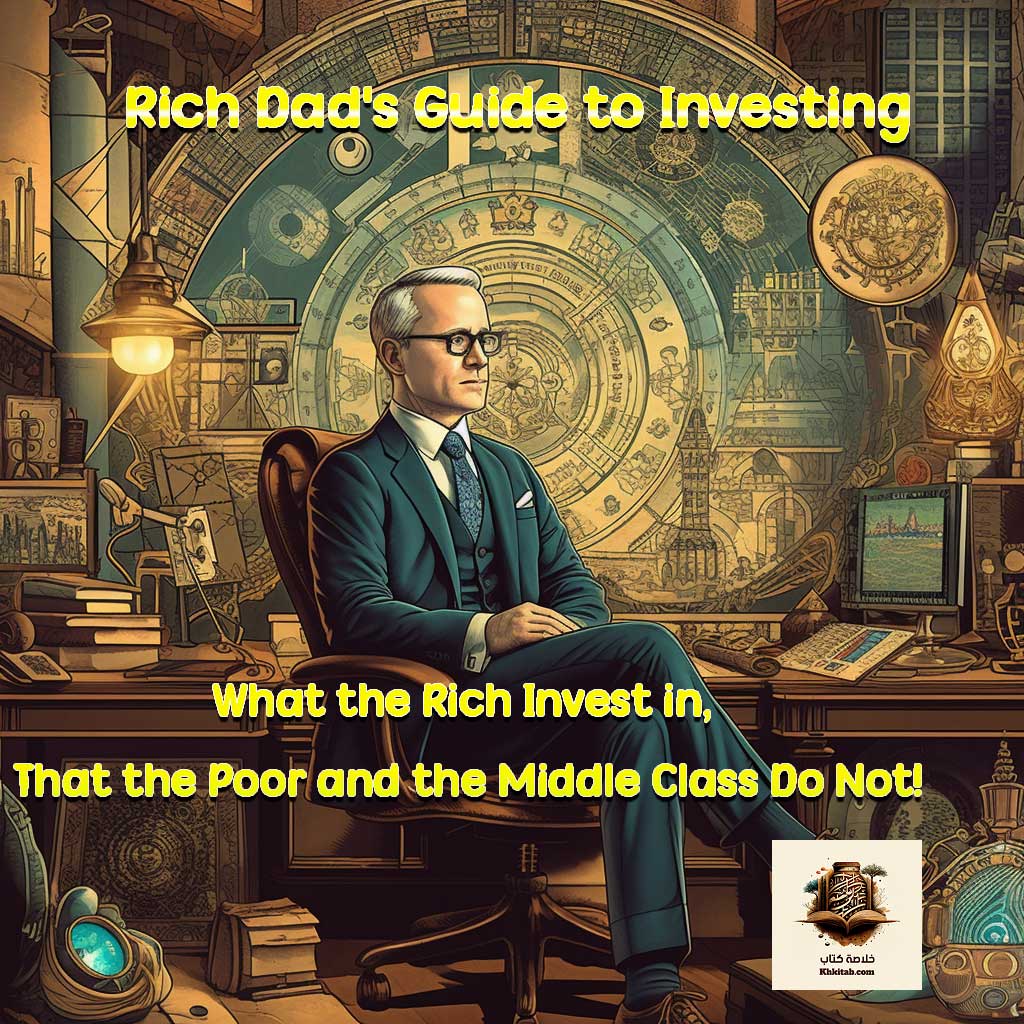Rich Dad’s Guide to Investing: What the Rich Invest in, That the Poor and the Middle Class Do Not! Book Summary

Have you ever wondered about the differences between the investment strategies of the rich and the poor? Robert Kiyosaki’s books provide a deep and detailed look into these strategies, and his “Rich Dad’s Guide to Investing: What the Rich Invest in, That the Poor and the Middle Class Do Not!”, stands out among them.
In this book, Kiyosaki explains how the rich invest in assets that generate income, while the poor and middle class invest in things they believe to be assets but in reality, drain money out of their pockets.
In this article, we will review this enlightening book filled with examples and experiences that illustrate this idea. We will delve into the secrets of wealth and investment strategies followed by the rich. Are you ready to step into the world of smart investing? Continue reading the article and immerse yourself in the rich and successful investment secrets with Kiyosaki.
Table of Contents
What are the Fundamental Differences in Investment Strategies Between the Rich, Middle Class, and Poor According to Rich Dad’s Guide to Investing?
Investment is a crucial tool for wealth creation and financial security. However, as outlined in Robert Kiyosaki’s “Rich Dad’s Guide to Investing: What the Rich Invest in, That the Poor and the Middle Class Do Not!”, the strategies and approach to investing can greatly differ based on one’s financial standing. Let’s delve deeper into understanding these differences.
The rich, in essence, possess a different mindset and have access to varied opportunities compared to the middle class and the poor. Their wealth allows them to invest in high reward ventures that may seem risky or inaccessible to others. Typically, they focus on generating passive income through investments in real estate, stocks, bonds, and businesses. In addition, the rich often have the advantage of financial advisors, which helps them make informed decisions and optimize their returns.
The middle class, on the other hand, often focuses on savings and traditional investment routes such as mutual funds, retirement funds, and insurance policies. These are considered safer, lower-risk investments but also provide comparatively lower returns. The middle class, due to their limited resources, often finds it challenging to diversify their investments and, thus, minimize risk exposure.
The poor, unfortunately, often lack access to investment opportunities. With limited resources, they are predominantly focused on meeting their daily needs. Investments, if any, are often in low-risk, low-return avenues such as savings accounts.
An essential distinction outlined by Kiyosaki is the mindset towards money and investment. The rich perceive money as a tool for wealth creation, not just a means for survival or comfort. They focus on financial education and continuously look for opportunities to grow their wealth. This mindset encourages them to take calculated risks and view failures as lessons.
On the contrary, the middle class and the poor often view money as a means of survival or comfort and are less willing to take financial risks. They also lack financial literacy, which prevents them from making informed investment decisions.
In conclusion, the rich, middle class, and poor differ significantly in their approach to investing. Their financial decisions are influenced by their wealth, access to opportunities, risk tolerance, and financial literacy. Therefore, to move up the wealth ladder, one needs to change not only their financial strategies but also their mindset towards money and investing.
Understanding Real Assets vs. Liabilities According to Rich Dad’s Guide to Investing
In the realm of personal finance, understanding the difference between assets and liabilities is fundamental. It is through this understanding that one can make informed financial decisions leading to wealth creation and financial freedom. Robert Kiyosaki’s book “Rich Dad’s Guide to Investing: What the Rich Invest in, That the Poor and the Middle Class Do Not!” provides critical insights into the concept of real assets and how they differ from liabilities.
In financial parlance, an asset is something that puts money into your pocket, while a liability takes money out of your pocket. The rich focus on acquiring assets, such as investments that generate income, while the poor and middle class accumulate liabilities that they mistakenly consider to be assets.
A real asset, as defined by Kiyosaki, is something that generates income without requiring the direct exchange of time for money. This includes investments like stocks, bonds, rental real estate, and businesses. These assets generate passive income and increase in value over time, contributing to the wealth of their owners. The rich understand the value of these real assets and continuously work to acquire and grow them.
إقرأ أيضا:فن أن تكون دائمًا على صواب: تكتيكات الإقناع الـ38On the contrary, liabilities are financial obligations or debts that lead to outflows of money. The common mistake made by the poor and the middle class is misinterpreting liabilities as assets. For instance, a personal car or a personal home is often seen as an asset. However, unless these items are generating income, they are liabilities. They require regular cash for maintenance, loan repayments, insurance, and other expenses without providing a regular income stream.
This confusion between assets and liabilities stems from a lack of financial education. Kiyosaki emphasizes that financial literacy is a key differentiator between the rich and the less wealthy. While the rich understand and utilize the power of income-generating assets, the poor and middle class tend to accumulate liabilities, thinking they are assets.
In conclusion, the path to wealth creation and financial freedom lies in the ability to differentiate between real assets and liabilities and in making informed decisions to acquire income-generating assets. Understanding this fundamental concept from “Rich Dad’s Guide to Investing” can be a significant step towards improving financial health and achieving financial goals.
Our Facebook Page – Book Summary
إقرأ أيضا:The Courage to Be Disliked: Insights on Freedom and HappinessThe Power of Real Estate Investment According to Rich Dad’s Guide to Investing
When it comes to wealth creation, real estate stands as one of the most proven and enduring strategies. This belief is fervently espoused in Robert Kiyosaki’s book, “Rich Dad’s Guide to Investing: What the Rich Invest in, That the Poor and the Middle Class Do Not!”. The book underlines the value of real estate investment as a powerful asset, a source of continuous income, and a pathway to financial independence.
Investing in real estate has long been a staple strategy for those seeking to build long-term wealth. The ‘rich dad’ ideology revolves around acquiring assets that generate income, and real estate perfectly embodies this principle. Properties, whether residential or commercial, generate a steady stream of cash flow through rental income, providing a steady stream of passive income to the investor.
Kiyosaki emphasizes that real estate investment goes beyond just being a reliable source of income. It’s a tangible asset that typically appreciates in value over time. Unlike certain other forms of investment, such as stocks, real estate is not as susceptible to short-term market fluctuations. It provides a measure of stability and predictability that is appealing to many investors.
Another significant advantage of real estate investment pointed out by Kiyosaki is the tax benefits it offers. With the right knowledge and guidance, real estate investors can leverage tax laws to their advantage. This can include deductions for mortgage interest, property taxes, operating expenses, and depreciation.
Despite these benefits, investing in real estate isn’t without its challenges. It requires significant knowledge, commitment, and capital. But as Kiyosaki’s ‘rich dad’ demonstrates, the learning and effort invested can result in a high payoff.
The book drives home the message that real estate isn’t just about owning property; it’s about strategic planning, informed decision-making, and financial discipline. The rich understand and leverage this, making real estate a cornerstone of their investment strategy.
In summary, “Rich Dad’s Guide to Investing” portrays real estate as a critical component of a rich person’s investment portfolio. Its ability to provide continuous income, appreciate in value, and offer tax advantages sets it apart as a potent tool for wealth creation and financial freedom. Understanding and leveraging the power of real estate investment can be a crucial step towards achieving one’s financial goals.
Creating Wealth through Business Investments: Insights from ‘Rich Dad’s Guide to Investing’
When it comes to strategies for wealth creation and financial freedom, investing in businesses stands as a crucial tactic. Robert Kiyosaki’s renowned book, “Rich Dad’s Guide to Investing: What the Rich Invest in, That the Poor and the Middle Class Do Not!”, provides valuable insights into this concept, reinforcing the importance of diversifying income sources and fostering an entrepreneurial spirit.
Kiyosaki emphasizes that merely earning a salary, even a hefty one, does not guarantee financial freedom. Instead, he encourages readers to invest in businesses, highlighting this as a common practice among the affluent. By owning businesses, they create assets that generate wealth continuously, even when they’re not actively working.
Investing in a business isn’t about having an active role in the day-to-day operations. Instead, it’s about being a business owner who can delegate the operations to capable managers. This concept parallels the principle of ‘working on your business, not in your business’. The advantage of this approach is the potential for creating a source of passive income, a cornerstone of the ‘rich dad’ philosophy.
The key, Kiyosaki explains, is to choose businesses wisely. It involves understanding the market, recognizing good business models, and evaluating the potential profitability. This process requires financial literacy, strategic planning, and an astute understanding of business dynamics.
While investing in businesses can offer lucrative returns, it comes with its share of risks. These include market changes, economic instability, and business-specific risks such as management issues or product failures. As Kiyosaki notes, successful investors don’t shy away from these risks. Instead, they learn to manage them effectively, transforming potential setbacks into opportunities for growth.
Moreover, the book underscores that investing in businesses doesn’t always mean starting from scratch. It could involve buying an existing business or investing in stocks, effectively owning a part of a larger company. By diversifying investments across various businesses, investors can mitigate risks and increase their income streams.
In conclusion, “Rich Dad’s Guide to Investing” posits that investing in businesses forms an integral part of the wealth-building strategies of the rich. By fostering financial literacy, taking calculated risks, and diversifying income sources, individuals can create a robust financial portfolio. Investing in businesses, therefore, stands as a potent tool in the quest for financial freedom and wealth creation.
A Guide to Investing in Securities: Key Lessons from ‘Rich Dad’s Guide to Investing’
Investing in securities such as stocks, bonds, and mutual funds has long been recognized as a viable strategy for wealth accumulation. Robert Kiyosaki’s seminal book, “Rich Dad’s Guide to Investing: What the Rich Invest in, That the Poor and the Middle Class Do Not!”, delves into this topic, offering valuable insights into the strategic approach the wealthy take towards securities investment.
Securities investment is a key component of financial portfolios, with the potential to generate significant returns. However, as Kiyosaki emphasizes throughout the book, understanding the intricacies of these investment vehicles is fundamental to success. This includes knowledge about market fluctuations, risk assessment, and potential returns.
In terms of stocks, Kiyosaki underscores the importance of investing in solid, well-managed companies with promising growth potential. The goal isn’t simply to buy low and sell high, but rather to recognize and invest in companies with strong business models and management teams. This approach requires a level of business acumen, and an understanding of financial statements, industry trends, and the overall market sentiment.
When it comes to bonds, they provide a more predictable income stream compared to stocks, which makes them a popular choice for conservative investors. Kiyosaki encourages investors to consider bonds as part of their diversified portfolio, as they can provide a steady income stream and balance out the risk associated with more volatile investments like stocks.
As for mutual funds, the book presents them as a feasible investment option, especially for beginners. Mutual funds pool money from numerous investors to create a large asset base, managed by professional fund managers. This diversification and professional management can make mutual funds an attractive option, particularly for those still learning the ropes of securities investment.
However, Kiyosaki also warns that investing in securities isn’t without risks. Market volatility can impact the value of stocks and mutual funds, while interest rate changes can affect bond prices. For this reason, he stresses the importance of financial education and due diligence when investing in securities.
In essence, “Rich Dad’s Guide to Investing” offers valuable lessons on investing in securities. It emphasizes the need for financial literacy, due diligence, and a strategic approach to investing. With these tools, individuals can effectively navigate the realm of securities investment and work towards achieving financial independence.
Business & Finance Management – Book Summary (khkitab.com)
The Power of Financial Education: Unpacking the Insights from ‘Rich Dad’s Guide to Investing’
Financial education is an integral aspect of attaining and maintaining wealth. It’s not just about earning money, but rather understanding how to make that money work for you. Robert Kiyosaki’s “Rich Dad’s Guide to Investing: What the Rich Invest in, That the Poor and the Middle Class Do Not!” places great emphasis on the importance of financial education for wealth creation.
Financial literacy is the foundation upon which all sound investment decisions are made. Kiyosaki uses his book to highlight this fact and explain why the rich often have a different approach to investing than the poor and middle class. For Kiyosaki, this disparity is largely due to differences in financial education.
According to Kiyosaki, the rich understand the value of investing in assets that generate income, such as real estate, businesses, and securities. They have a firm grasp on financial concepts such as cash flow, compound interest, and asset allocation. They understand the difference between assets and liabilities, and they know how to use debt to their advantage.
Moreover, financial education goes beyond just understanding numbers on a balance sheet. It also involves an understanding of tax laws and regulations, market dynamics, and global economic trends. Kiyosaki points out that these are the areas where the rich focus their learning, which gives them a competitive edge in wealth creation.
In “Rich Dad’s Guide to Investing”, Kiyosaki also argues that the financially educated are better equipped to handle investment risks. They understand that every investment comes with some degree of risk, but through financial literacy, they learn how to mitigate these risks. They use diversification, research, and strategic planning to manage their investments and limit potential losses.
But perhaps the most important takeaway from Kiyosaki’s book is the idea that financial education is a lifelong journey. The economic landscape is constantly changing, and staying financially literate means keeping up with these changes. The rich understand this, which is why they are continually learning and adapting.
In conclusion, “Rich Dad’s Guide to Investing” underscores the significance of financial education in wealth creation and maintenance. By understanding money, investments, and the economy, individuals can make informed decisions, mitigate risk, and ultimately, create sustainable wealth. The book serves as a powerful reminder that financial education is not just for the rich – it’s a necessity for anyone who wants to improve their financial situation and attain financial independence.
Investing as a Continuous Activity: Delving into ‘Rich Dad’s Guide to Investing’
Investing, as explained by Robert Kiyosaki in his influential book, “Rich Dad’s Guide to Investing: What the Rich Invest in, That the Poor and the Middle Class Do Not!”, is not merely a passive act of buying and selling assets. It is a continuous, active endeavor that involves regular planning, learning, and evaluation. A deep dive into this concept unveils the real-world implications of viewing investing as an ongoing activity.
For starters, Kiyosaki emphasizes the need for continuous planning. Successful investing does not come from random, ad hoc decisions. Instead, it necessitates a well-thought-out strategy that aligns with individual financial goals and risk tolerance. Such a plan serves as a roadmap to navigate the investment landscape and aids in making informed decisions that resonate with one’s financial aspirations.
Learning is another critical component of the investing journey. By committing to ongoing education about financial markets, investment vehicles, and economic indicators, investors can better understand the dynamics that drive asset prices. This knowledge, combined with practical experience, enables investors to identify promising investment opportunities and assess potential risks accurately.
Evaluation is the third pillar that supports the concept of investing as a continuous activity. Regularly reviewing and reassessing one’s investment portfolio is crucial in responding effectively to market fluctuations or changes in personal circumstances. This ongoing assessment aids in adjusting investment strategies when necessary, ensuring that they remain optimally aligned with an investor’s evolving goals and market realities.
Furthermore, Kiyosaki’s perspective dispels the notion that successful investing is about timing the market perfectly or finding a ‘silver bullet’ investment. It reinforces the idea that there are no shortcuts to investment success. Instead, success in the investing world comes from consistent effort, sound financial knowledge, and a commitment to continual learning and evaluation.
In essence, “Rich Dad’s Guide to Investing” encourages its readers to view investing as an active, ongoing process rather than a one-time event. This perspective aligns with the practices of the wealthy, who understand that it takes time, patience, and a lot of learning to build wealth through investing. The book serves as a guide to cultivating a proactive and informed approach to investing, a strategy that the rich use to increase and preserve their wealth.
Leveraging Financial Advice for Investment Success: A Look into ‘Rich Dad’s Guide to Investing’
“Rich Dad’s Guide to Investing: What the Rich Invest in, That the Poor and the Middle Class Do Not!” by Robert Kiyosaki is a treasure trove of financial wisdom and practical advice. One pivotal point that Kiyosaki strongly emphasizes is the significance of obtaining financial advice from experts when making investment decisions. This article will dive deep into this subject, discussing the reasons and benefits behind seeking financial advice.
In the realm of investing, knowledge is indeed power. Having a strong grasp of financial markets, understanding the dynamics of various investment vehicles, and being able to interpret economic indicators are all crucial elements of making sound investment decisions. However, given the complexity of these topics and the time it takes to acquire such understanding, Kiyosaki advises readers to leverage the expertise of financial advisors.
A well-qualified financial advisor brings to the table a wealth of knowledge and experience that can be instrumental in shaping an effective investment strategy. They can offer insights into market trends, identify potential investment opportunities, and provide guidance on risk management, enabling investors to navigate the financial landscape with increased confidence and acumen.
Moreover, financial advisors can offer a fresh perspective on your investment plans, challenging your assumptions and encouraging you to think more critically about your decisions. They can help align your investment strategy with your long-term financial goals, ensuring that each step you take is a step towards financial security and wealth creation.
However, the importance of choosing the right financial advisor cannot be overstated. The ideal advisor should have a proven track record, demonstrate a deep understanding of the markets, and above all, should align with your investment philosophy and financial aspirations.
Kiyosaki’s emphasis on seeking expert advice underscores his larger message about investing: it is not a solitary activity. Instead, successful investing is often a collaborative process that involves leveraging collective wisdom, learning from others’ experiences, and actively seeking out expert advice to make informed, strategic decisions.
In summary, “Rich Dad’s Guide to Investing” promotes the idea of viewing investment not as a lone venture, but as a team effort. The team comprises not only of the investor but also of knowledgeable advisors who can provide invaluable advice, guidance, and insight. By embracing this approach, investors can avoid common pitfalls, make more informed decisions, and ultimately, increase their chances of achieving financial success.
Learning from Investment Mistakes: Key Insights from ‘Rich Dad’s Guide to Investing’
One of the indispensable life skills that successful investors often possess is the ability to learn from their mistakes. Robert Kiyosaki, in his renowned book “Rich Dad’s Guide to Investing: What the Rich Invest in, That the Poor and the Middle Class Do Not!” accentuates this point strongly. This article delves into how learning from mistakes can be a transformative growth strategy in the investing journey.
Investing, by nature, involves a certain degree of risk and uncertainty. Even the most seasoned investors may face setbacks and losses. According to Kiyosaki, the key differentiator between successful and unsuccessful investors is how they react to these setbacks. Successful investors do not allow their mistakes to discourage them. Instead, they see them as learning opportunities and leverage them to refine their investment strategies.
Kiyosaki stresses that mistakes are often the most potent learning tools. They provide valuable insights into what doesn’t work and highlight areas that require improvement. By analyzing their mistakes, investors can gain a clearer understanding of the investment landscape and make more informed decisions in the future.
Moreover, mistakes can help investors develop a stronger risk management strategy. By understanding the factors that contributed to a failed investment, investors can identify potential risks in future investments and take steps to mitigate them. This process of learning from mistakes thus not only leads to better investment decisions but also promotes a more risk-aware investing approach.
However, the value of learning from mistakes does not negate the importance of thorough due diligence and careful planning. Investors should still strive to minimize errors by researching potential investments, consulting with financial advisors, and staying updated on market trends and economic indicators. Nonetheless, when mistakes do occur, they should be seen not as failures, but as valuable lessons that can contribute to future success.
In conclusion, “Rich Dad’s Guide to Investing” conveys a crucial message to investors: Embrace your mistakes, learn from them, and use them as stepping stones towards becoming a more knowledgeable and successful investor. This approach, according to Kiyosaki, is a common characteristic among the rich investors, setting them apart from the poor and the middle class. By adopting this mindset, any investor can turn their setbacks into setups for greater success in their investment journey.
Mastering Financial Analysis: Unveiling Investment Opportunities with ‘Rich Dad’s Guide to Investing’
Understanding financial analysis is a crucial part of making effective and profitable investments. In Robert Kiyosaki’s celebrated book, “Rich Dad’s Guide to Investing: What the Rich Invest in, That the Poor and the Middle Class Do Not!”, this concept is explored thoroughly. This article aims to decode the significance of financial analysis as a key tool in revealing potential investment opportunities, as depicted in the book.
Financial analysis is the examination of financial information to make investment decisions. It involves evaluating the financial health and profitability of companies, considering the economic landscape, and understanding market trends. According to Kiyosaki, successful investors, particularly the rich, invest their time in understanding the nuances of financial analysis and apply them diligently to discover profitable investment opportunities.
One of the central themes in Kiyosaki’s book is the differentiation between assets and liabilities. Through robust financial analysis, investors can identify which investments are true assets, providing regular income, and which ones are liabilities, or potential financial burdens. This distinction is paramount in developing a portfolio that generates wealth.
Moreover, the book encourages the use of financial statements – balance sheets, income statements, and cash flow statements – as a tool for financial analysis. These statements provide a wealth of information about a company’s financial health, profitability, and cash flow. By understanding how to interpret these documents, investors can better evaluate potential investments.
Kiyosaki also underlines the importance of industry and economic analysis in investment decisions. By understanding the broader economic and industry trends, investors can identify sectors and companies with growth potential. This macro-level analysis can lead to more informed and strategic investment decisions.
Lastly, risk analysis is a crucial aspect of the financial analysis process, as discussed in the book. It is important for investors to understand the potential risks associated with an investment. This includes both systematic risks, such as market or economic conditions, and unsystematic risks, such as company-specific issues. Thorough risk analysis helps investors make decisions that align with their risk tolerance and investment objectives.
To conclude, “Rich Dad’s Guide to Investing” emphasizes that mastering financial analysis is a stepping stone towards successful investing. By understanding and applying the principles of financial analysis, investors can uncover lucrative investment opportunities and make more informed decisions, distinguishing themselves from the poor and middle class. The path to wealth creation, as per Kiyosaki, is greatly facilitated by this essential skill.
Rich Dad’s Guide to Investing: What the Rich Invest in, That the Poor and the Middle Class Do Not! Book Summary








